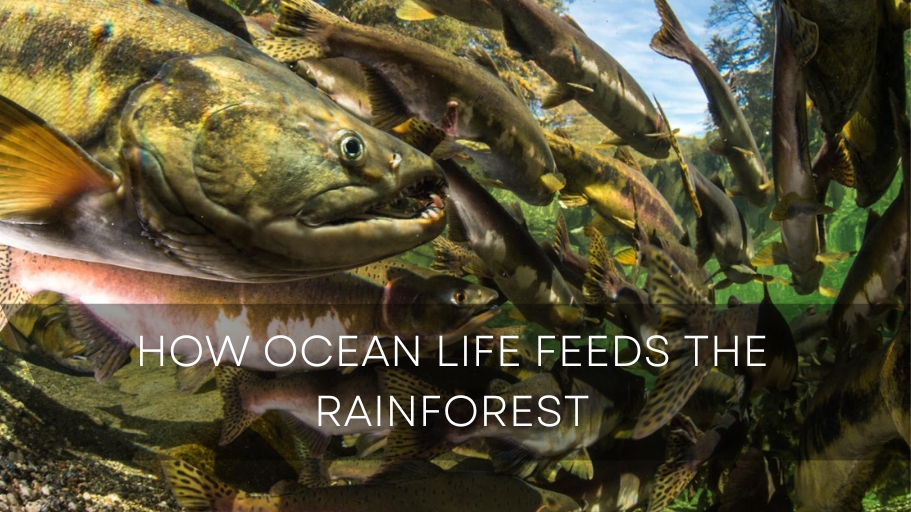Ian McAllister on How Ocean Life Feeds the Rainforest
This post was last updated on January 18th, 2024

Rainforests, often described as the Earth’s lungs, are teeming with life. But it’s not just the rainforest itself that’s alive and thriving; it’s intricately connected to the ocean’s ecosystem.
This relationship between rainforests and marine life, notably salmon and herring, is a complex yet fascinating subject. These fish and other oceanic nutrients are vital in feeding the rainforests and maintaining ecological balance.
Ian McAllister is a renowned conservationist, photographer, and environmental advocate who has dedicated his life to understanding and preserving the complex relationship between ocean life, notably salmon and herring, and the vibrant rainforests of Canada’s west coast and the Great Bear Rainforest. Through years of fieldwork, research, and visual storytelling, he has illuminated how marine nutrients act as a vital lifeline for rainforests. His passion for wildlife and ecological balance makes him a respected authority on the intricate connections that bind the seas to the forests.
“The dance of salmon and herring is more than a migration; it’s a vital symphony that binds ocean and forest, nourishing life in a delicate balance that must be fiercely protected for the health of our planet,” says Ian McAllister.
Contents
ToggleThe Great Nutrient Exchange
Salmon and Herring Migration
Salmon and herring are known for their extensive migration patterns. Salmon, for example, travel thousands of miles, moving from freshwater rivers to the ocean and back again to spawn. Herring, too, follow distinct migratory routes.
The migration of salmon is not just a remarkable journey but an essential ecological process that serves as a biogeochemical conveyor belt. During their life in the ocean, salmon accumulate nutrients like nitrogen and phosphorus within their muscles, eggs, and overall body tissues. These nutrients are derived from the marine food web, starting from microscopic algae and working their way up through the chain of life.
The Journey Upstream
During their journey upstream to spawn, salmon carry essential nutrients from the ocean into rivers and streams. These nutrients are found in their bodies, eggs, and waste.
When the time comes for the salmon to spawn, they embark on an arduous journey upstream to their natal rivers and streams. This journey is not just about reproduction; it’s about transporting those accumulated nutrients from the marine environment into freshwater ecosystems.
As they travel, die, and decay post-spawning, the nutrients within their bodies are released into the surrounding water and soil. This isn’t a one-way transfer; it’s a dynamic exchange. The nutrients enhance the productivity of freshwater ecosystems, supporting the growth of algae and invertebrates, which, in turn, feeds other fish and wildlife. Even the trees and plants along the riverbanks benefit from these nutrients, as they can be absorbed through roots or deposited by animals that have consumed the fish.
“In essence,” McAllister says, “the salmon act as a vital link, a living bridge between the sea and land, recycling marine nutrients into terrestrial and freshwater systems.”
The Marine Nutrient Cycle
The marine nutrient cycle is an incredible phenomenon linking the ocean and forest ecosystems:
1. From Ocean to Forest
Salmon and herring consume plankton, algae, and other ocean organisms rich in nutrients such as nitrogen and phosphorus. When they return to freshwater streams to spawn, these nutrients are transferred from the ocean.
2. Feeding the Forest Fauna
Bears, birds, and other forest animals feast on the migrating fish. In doing so, they disperse these nutrients further into the forest.
3. Nutrients in the Soil
The remains of the fish and animal waste enrich the soil with nitrogen, phosphorus, and other essential minerals.
4. Flourishing Flora
These nutrients stimulate plant growth, nourishing not only the trees but also the entire rainforest ecosystem.
“Cycles of life in nature are more interconnected than we often realize,” says Ian McAllister. “The migratory dance of salmon and herring feeds more than just the marine world; it fuels the very essence of our forests. As bears and birds partake in this feast, they become conduits of nourishment, channeling ocean-derived nutrients into the heart of our rainforests. The remains left behind become the soil’s sustenance, sparking a chain of growth that breathes life into the flora. It’s not merely a process; it’s a symphony of life connecting sea to forest, a testament to our Earth’s intricate design.”
Herring’s Role
Herring’s contribution to this cycle is often overlooked but equally vital. Herring are an essential food source for various marine and bird species. Their migration helps distribute nutrients across different oceanic regions, indirectly influencing the nutrient availability that eventually makes its way to the forest ecosystem.
The Delicate Balance
The interaction between the rainforest and marine life, especially salmon and herring, is a delicate balance that maintains the health and diversity of both ecosystems. Overfishing, climate change, and habitat destruction can threaten this balance, leading to unforeseen consequences across the biosphere.
“Disturbing this balance through overfishing, habitat destruction, or climate change isn’t just an assault on these species,” McAllister reminds us. “It’s a global threat that could unravel the fabric of our ecosystem. Protecting these links is a fundamental responsibility we hold for the future of our planet.”
Salmon, herring, and the marine nutrients they carry serve as lifeblood, connecting oceans and rainforests in a remarkable natural dance. Understanding and preserving this relationship is essential not only for the health of these ecosystems but for the planet as a whole. Efforts to protect migration routes, reduce overfishing, and safeguard habitats are not just a conservation concern; they are a global imperative that ensures the continuation of this intricate and vital ecological connection.
About Ian McAllister
Ian McAllister, a devoted advocate for wildlife protection, has spent many years capturing the awe-inspiring beauty of Canada’s west coast. Through his captivating photography and films, he has played a vital role in raising awareness about the urgent need to safeguard the Great Bear Rainforest. McAllister’s passion for environmental conservation has touched people’s hearts worldwide, inspiring them to appreciate and protect our planet’s natural wonders.
Recommended For You
Unusual Uses of Aspirin – Quick Read
Most Inside
Most Inside offers high-quality recommendations and valuable updates to enhance all aspects of your life, providing premium guidance and enriching experiences.




